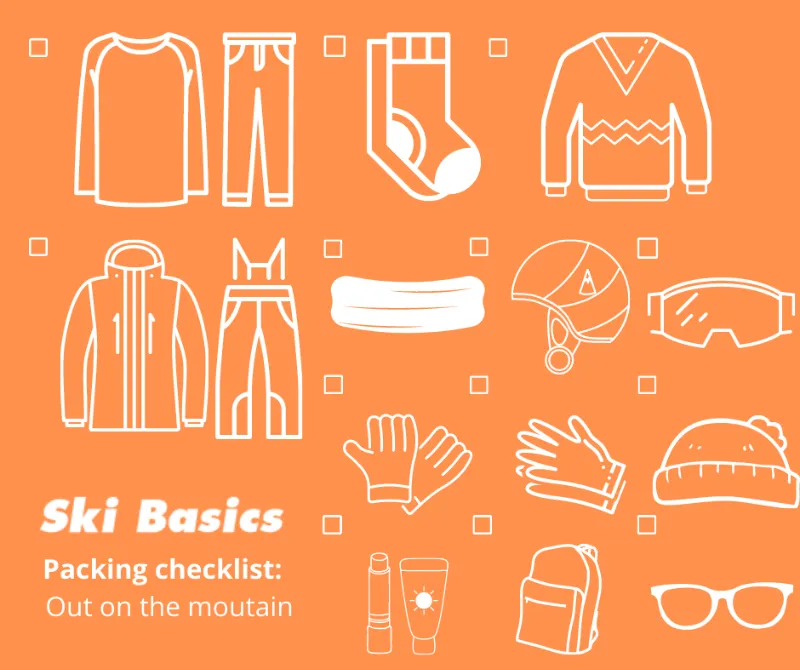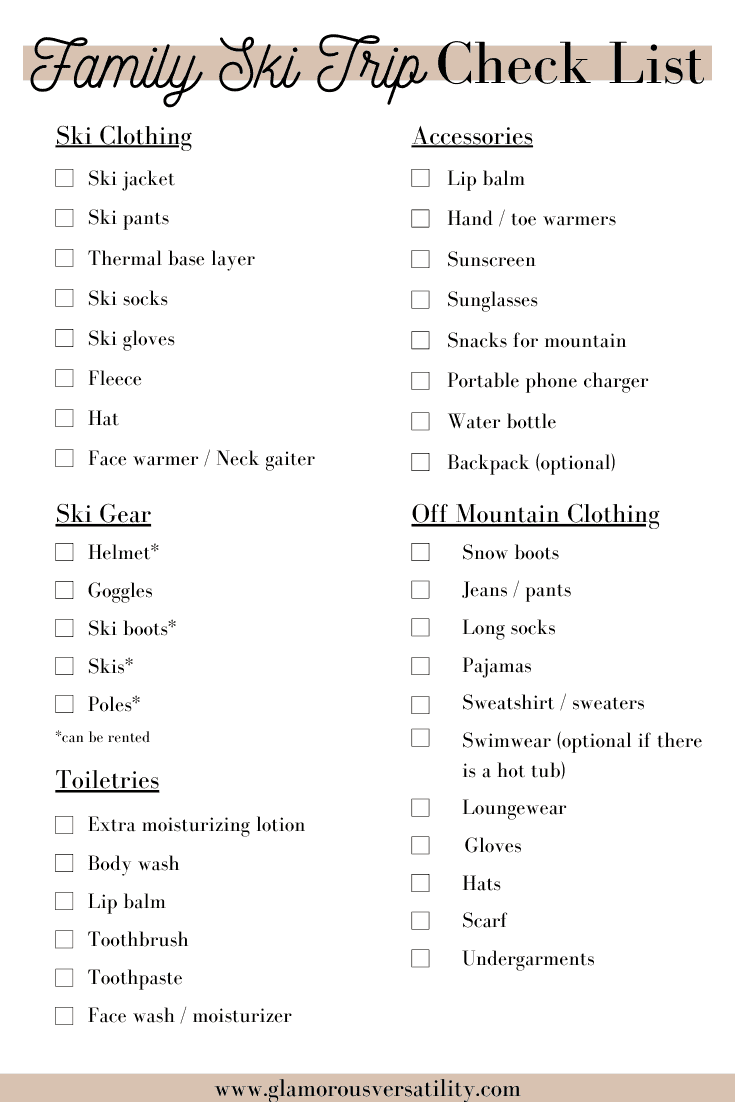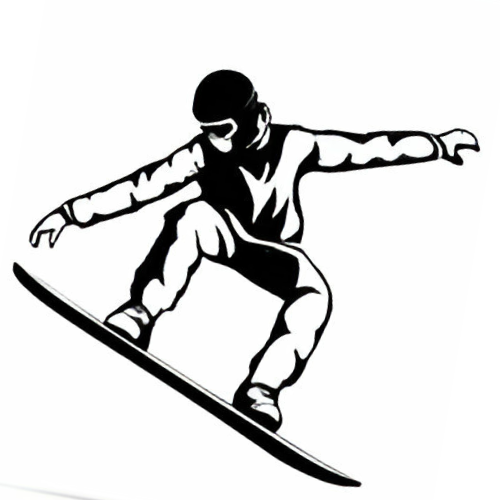Bring essential skiing gear such as skis, boots, and poles, along with suitable cold-weather clothing. Don’t forget goggles, gloves, and a helmet for protection.
Embarking on a skiing adventure requires thoughtful preparation to ensure both comfort and safety on the slopes. The key to a successful ski trip lies in packing the right equipment and apparel. You’ll need high-quality, insulated ski attire to keep you warm against the biting cold.
Your checklist should prioritize thermal layers, waterproof ski pants, and a jacket. Good visibility is vital, so high-quality goggles that resist fogging are a must. Protecting your head with a sturdy, well-fitting helmet cannot be overstated. To maintain dexterity in freezing temperatures, invest in a pair of gloves that offer both warmth and grip. Remember, proper gear can make or break your skiing experience, so choose items that provide the perfect balance of safety, comfort, and performance.

Credi: www.skibasics.com
Gearing Up For The Slopes
As winter’s white blanket envelops the mountains, the thrill of skiing beckons. Preparation is crucial before hitting the slopes. The right gear ensures a safe and enjoyable ski experience. With this guide, choosing essential skiwear and adopting effective layering strategies becomes straightforward.
Essential Apparel
Starting with the essentials, skiers must prioritize warmth and safety. This apparel checklist covers the basics:
- Ski Jacket: Waterproof and insulated.
- Ski Pants: Must fit comfortably over layers.
- Gloves: Waterproof and insulated for warmth.
- Goggles: UV protection for eye safety.
- Helmet: Proper fit is vital for safety.
- Socks: Breathable, warm ski socks.
Layering Strategies
Layering keeps skiers warm but not sweaty. Effective layering involves three key layers:
- Base Layer: Moisture-wicking to keep skin dry.
- Mid Layer: Insulating to retain body heat.
- Outer Layer: Protective against wind and snow.
| Layer | Function | Material Examples |
|---|---|---|
| Base | Moisture Management | Synthetic fibers, Wool |
| Mid | Insulation | Fleece, Down, Synthetic insulation |
| Outer | Protection | Gore-Tex® |
Head To Toe: Comprehensive Guide
Embarking on an adventure down snowy slopes calls for the right gear. A comprehensive guide ensures every skier is well-equipped from head to toe. This guide highlights essential items to optimize safety, comfort, and performance. Proper preparation amplifies the skiing experience.
Helmets And Headwear
Head protection is non-negotiable on the slopes. The right helmet can save lives. When selecting a helmet, consider the following:
- Size and fit: A snug, comfortable fit is crucial. It should not wobble or press uncomfortably.
- Weight: Lighter helmets cause less fatigue. Pick one that feels right.
- Ventilation: Adjustable vents help regulate temperature.
- Safety standards: Look for certifications like ASTM or CE EN.
Additionally, a helmet-compatible beanie or headband maximizes warmth. Aim for moisture-wicking materials to stay dry.
Goggles And Visibility
Clear vision is key for skiing success. Consider these aspects when choosing goggles:
| Feature | Function |
|---|---|
| Lens color and tint | Improves contrast and depth perception in various light conditions. |
| UV protection | Shields eyes from harmful rays. |
| Anti-fog | Maintains clarity with a dual-lens system or anti-fog coating. |
| Frame fit | Must be compatible with the helmet for a seamless fit. |
Don’t forget a microfiber cloth to gently clean the lenses. A hard case protects goggles in your bag.
The Core Of Ski Outfits
Getting ready for the slopes means starting with the core essentials of ski outfits. The right jacket and pants are not just about looking good; they’re also about keeping warm, dry, and enjoying the ski experience to the fullest. Let’s dive into what makes for the best ski attire.
Jackets And Waterproofing
A high-quality ski jacket is your first line of defense against the elements. Here are the must-haves:
- Waterproofing: Look for jackets with a high waterproof rating, often measured in millimeters.
- Breathability: Breathable fabrics help release sweat and reduce overheating.
- Windproof: A windproof barrier is key to staying warm on windy chairlifts.
- Insulation: Options vary from down to synthetic – pick one according to personal preference and climate.
| Feature | Description | Benefit |
|---|---|---|
| Waterproof | 10,000mm rating or more | Keeps you dry |
| Breathable | Ventilation zips or breathable fabric | Regulates temperature |
Pants And Insulation
Insulated ski pants shield your legs from cold and moisture. Here’s what to seek in a good pair:
- Lined Insulation: Keeps the warmth in and the cold out.
- Waterproof Rating: Like jackets, a higher rating means better water resistance.
- Fit: Ensure they allow for layering and movement without being too bulky.
- Features: Look for useful extras like snow gaiters, reinforced cuffs, and ample pockets.
| Feature | Importance | Tip |
|---|---|---|
| Fit | Crucial for comfort | Layer without restrict |
| Water Resistance | Keeps legs dry | Look for taped seams |

Credit: tarynnewton.com
Must-have Accessories
Heading to the slopes without must-have accessories is like skiing without snow. These essentials keep you warm and ensure a smooth day of carving down the mountain. Dive into the critical extras no ski enthusiast should overlook.
Gloves Versus Mittens
Having warm hands is crucial on the slopes. Your choice can make or break your experience. Gloves offer more dexterity, perfect for adjusting gear. Mittens keep fingers together, generating extra warmth. Consider these points:
- Material: Waterproof and breathable fabrics work best.
- Insulation: Look for features like Thinsulate or down.
- Wrist straps: These prevent snow from seeping in.
Scarves And Neck Gaiters
Protecting your face and neck from frosty winds is essential. Scarves add a traditional touch, while neck gaiters offer modern, practical coverage. Both provide benefits:
| Accessory | Benefits | Materials |
|---|---|---|
| Scarves | Style flexibility, customizable wrapping | Wool, Fleece, Synthetic blends |
| Neck Gaiters | Snug fit, easy to wear | Merino wool, Polyester |
Beneath The Surface
Smart skiers know that comfort starts beneath the surface. Your performance on the slopes relies on layers. These hidden heroes work tirelessly to keep the cold at bay. Let’s dive into the essentials under your ski suit!
Thermal Base Layers
Selecting the right thermal base layers is critical. These layers trap heat and wick moisture away from your skin. Look for materials like merino wool or synthetic fibers. They offer the best insulation and dry quickly.
- Merino Wool: Natural heat retention and odor resistance
- Synthetic Fibers: Quick-drying and durable
A snug fit ensures no heat escapes. Yet, these layers should not restrict movement. Aim for a balance!
Socks That Make A Difference
Never underestimate the power of quality ski socks. They will keep your feet warm and dry all day. A blend of wool and synthetic materials is perfect.
| Material | Benefits |
|---|---|
| Wool Blend | Warmth, cushioning |
| Synthetics | Moisture-wicking, durability |
Pick socks without bulky seams. Seams can cause discomfort in your boots. Padding in the shin and sole adds extra cushioning and protection.
Remember, the right fit is key. Too tight and you risk cutting off circulation. Too loose and you lose beneficial heat.

Credit: themomedit.com
Choosing The Right Ski Equipment
When you’re ready to hit the slopes, having the right ski equipment is crucial. It ensures safety and improves your performance.
Skis And Bindings Selection
Finding the perfect pair of skis is about matching your gear to your skiing style. Consider these factors:
- Length: Short skis turn quickly, while long skis are stable at speed.
- Width: Wider skis are better for powder; narrow ones are quick on groomed runs.
- Profile: Camber aids in turn initiation, and rocker helps in deep snow.
Bindings are just as important. Make sure they match your ski level and are set to your weight.
Boot Fitting And Comfort
A good boot fit is essential for a great day on the slopes. Measure your feet and consider these points:
| Aspect | Consideration |
|---|---|
| Size | Must be snug, but not too tight. |
| Flex | Stiffer boots for racing, softer for freestyle. |
| Shape | Should match your foot’s shape for comfort. |
Remember, your boots need to work with your bindings. Always check compatibility.
Additional Considerations
Before you hit the slopes, remember a fun trip starts with smart packing. Let’s explore what extra gear can make your day better. A little planning ensures comfort and fun on your ski adventure.
Backpacks And Storage
Choosing the right backpack can keep your hands free and your gear safe. Look for bags with:
- Water resistance to keep contents dry.
- Multiple compartments for easy organization.
- Comfortable straps for all-day wear.
A great backpack will have enough space for:
- Extra clothing layers.
- Emergency kit and tools.
- Your hydration system or water bottle pocket.
Hydration And Nutrition
Skiing is tough work. Stay hydrated and energized. Here are some tips:
| Hydration | Nutrition |
|---|---|
| Insulated water bottle to prevent freezing. | Pack energy bars for quick fuel. |
| Hydration pack for easy access sips. | Nuts and dried fruit for longer energy. |
Remember to take sips regularly, even if you don’t feel thirsty. Your body loses a lot of water when active in cold weather.
Safety First: Protective Gear
Protective gear is a must on the slopes. It shields you from injuries. You stay warm and enjoy skiing more. This section covers essentials to keep you safe.
Impact Shorts And Pads
Impact shorts and pads cushion your falls. They are a skier’s best friend. Your hips, thighs, and tailbone need this protection.
- Impact Shorts: Wear them under your pants.
- Knee Pads: They protect your knees during a tumble.
- Wrist Guards: A fall can hurt your wrists. Pads help.
Choose gear that fits well. It should not limit your moves.
Avalanche Safety Devices
Avalanches are real risks. Be prepared with the right devices.
| Device | Use |
|---|---|
| Beacon: | Helps rescuers find you. |
| Probe: | Locates buried victims. |
| Shovel: | Digs out snow quickly. |
Practice using these devices. Stay with your group. Watch for avalanche signs.
Tech Advancements
Embracing Tech Advancements is transforming the skiing experience. Skiers now enjoy more safety, comfort, and connectivity. Let’s explore must-have gadgets featuring the latest technology.
Gps And Tracking Technologies
Staying safe on the slopes is simpler with GPS and tracking devices. These gadgets help you navigate trails and monitor your location. Look for:
- Handheld GPS devices – compact and precise.
- Wearable tech – watches and trackers sync with mobile apps.
- Ski apps – offer maps and track speed, distance, and altitude.
Skiing buddies can stay connected even in remote areas:
- Two-way radios – for group communication.
- Smartphone adapters – enhance signal reach.
Apparel With Built-in Electronics
Apparel with built-in electronics heats your body and connects to your devices. Outfit with these smart clothes:
- Heated jackets and gloves – offer temperature control.
- Bluetooth beanies – allow music listening and calling.
- Smart socks – track foot warmth and pressure.
These garments incorporate lightweight batteries and are water-resistant:
| Item | Feature |
|---|---|
| Heated jackets | Adjustable heat settings |
| Bluetooth beanies | Built-in headphones |
| Smart socks | Sensors for heat and pressure |
Sustainable Skiing
As the snow whispers under your skis, remember that each glide can be a step towards protecting our winter wonderlands. Sustainable skiing is not just a trend; it’s our responsibility. Let’s prepare for the slopes by choosing items that love our planet as much as we do.
Eco-friendly Gear Options
Embarking on your snowy adventures doesn’t mean compromising the environment. Opt for gear made with recycled materials or from companies committed to sustainability. Below is a list of eco-conscious choices:
- Biodegradable wax to keep your skis smooth and the environment clean.
- Eco-friendly outerwear that uses sustainable fabrics and production methods.
- Bamboo poles which are not just durable but also a renewable resource.
- Solar-powered watches to track your runs without the need for battery replacements.
Maintaining Equipment For Longevity
Quality care for your ski gear means it will last longer, reducing waste and the need for frequent replacements. Follow these simple yet impactful tips:
- Regularly clean and wax your skis or snowboard to enhance performance and durability.
- Store equipment in a cool, dry place to prevent damage.
- Get your gear professionally tuned at the end of each season to keep them in prime condition.
Investing in a quality maintenance kit also ensures you have all you need to care for your gear year-round.
FAQ
What Do I Need To Go Skiing For The First Time?
For your first skiing adventure, you’ll need skis, boots, poles, appropriate ski clothing, gloves, goggles, and a helmet. Consider taking a ski lesson to learn the basics safely.
What Do You Need For A Ski Day?
For a successful ski day, pack skis, poles, ski boots, a helmet, and goggles. Wear layers, including thermal underwear, a fleece jacket, and waterproof ski pants and jacket. Don’t forget gloves, a warm hat, and sunscreen.
How Do You Pack For A 3 Day Ski Trip?
Pack essential clothing, including base layers, insulation, and waterproof outerwear. Remember goggles, gloves, and warm hats. Include ski boots, skis, poles, and helmet. Bring personal items, snacks, and a reusable water bottle. Keep travel size toiletries and a first-aid kit handy.
How Do You Pack For A Week Of Skiing?
Start by choosing a durable bag. Pack thermal layers, ski socks, and waterproof outerwear. Include gloves, a hat, and UV-protection goggles. Don’t forget your helmet and ski boots. Condense items using compression bags and check the weather forecast for any additional gear needs.
Conclusion
As you gear up for the slopes, remember the essentials: the right clothing, protective gear, and personal items. Every item on our list ensures a safe, comfortable skiing adventure. Pack smart, and you’ll carve up the runs with confidence. Make this ski trip unforgettable by being well-prepared.
Enjoy the snow!
